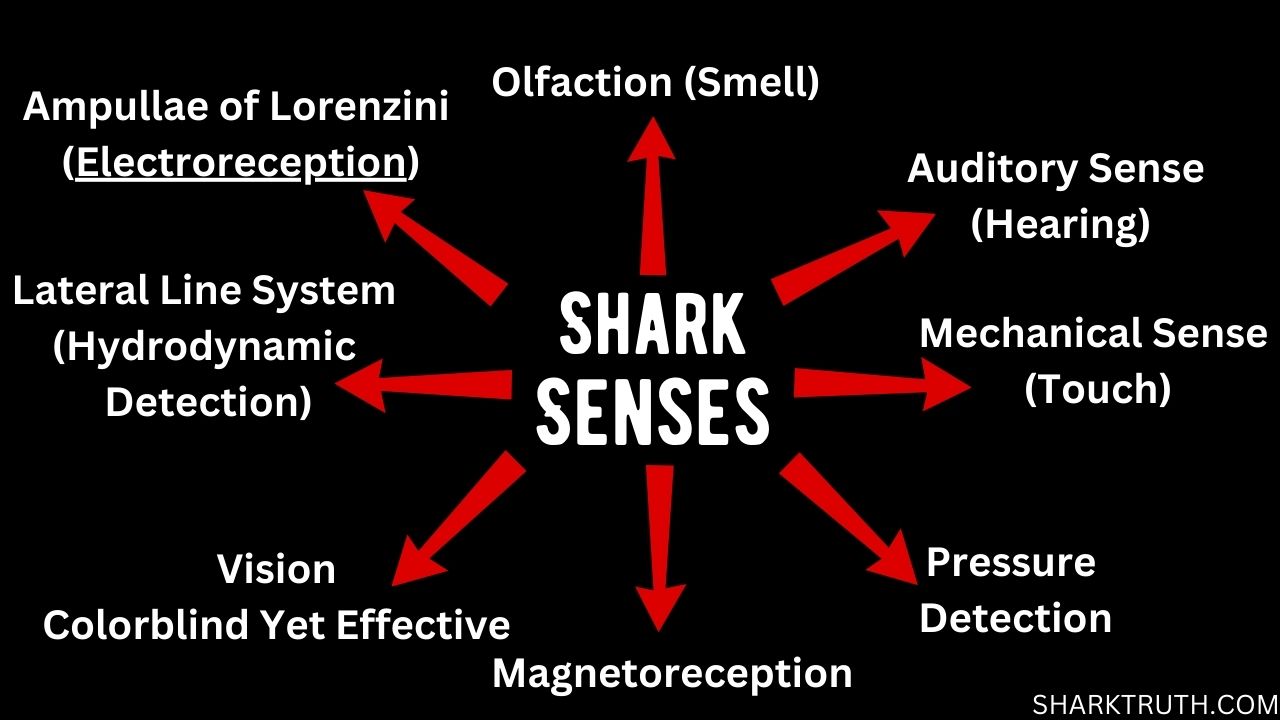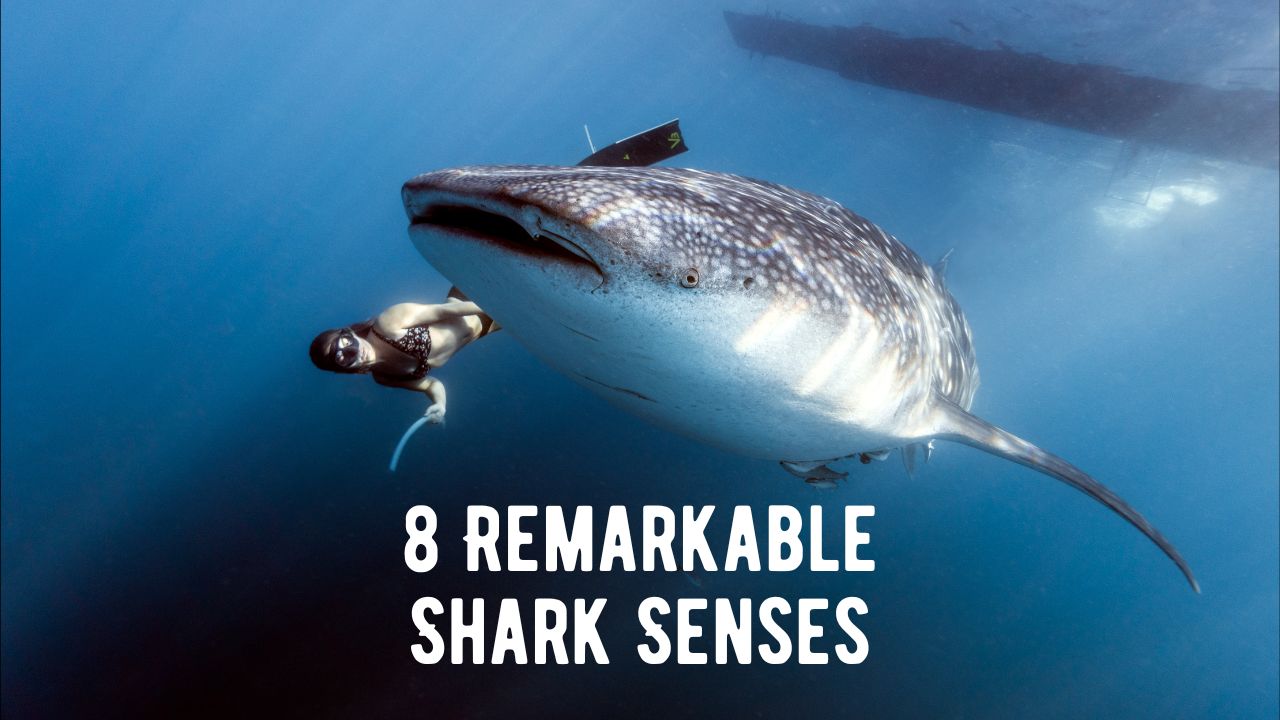As ancient and apex ocean predators, sharks have evolved an impressive array of sensory adaptations, contributing to their success in diverse marine environments. These remarkable creatures boast not five but eight senses, each finely tuned to navigate their surroundings, locate prey, and avoid potential threats. Eight Shark’s highly refined senses include smell, hearing, touch, taste, sight, pressure detection, hydrodynamics, and electromagnetism.
This comprehensive article will delve into the fascinating world of shark senses, exploring each sensory system’s anatomy, function, and evolutionary significance.

Vision:
Sharks are not known for their acute vision, but they are equipped with eyes well-adapted to low-light conditions. Their eyes possess many rod cells, specialized for low-light vision, and a tapetum lucidum that enhances their ability to see in dimly lit waters. Despite the common belief that sharks are colorblind, recent research suggests that some species may have limited color vision. The position and structure of their eyes contribute to an expanded field of view, allowing them to detect movement over a wide area.
Olfaction (Sense of Smell):
The sense of smell in sharks is nothing short of extraordinary. Their olfactory system is highly developed; some species can detect blood at incredibly low concentrations. The olfactory epithelium, lining the nasal cavity, is filled with sensory cells that can identify specific chemical compounds. The vomeronasal organ enhances their ability to detect pheromones, aiding social interactions and mating. Sharks use their sense of smell to locate prey over long distances, often following scent trails for miles.
Ampullae of Lorenzini (Electroreception):
One of the sharks’ most unique and distinctive features is the ampullae of Lorenzini, specialized electroreceptor organs located in the skin around the head and snout. These jelly-filled pores detect the electric fields of prey animals’ muscle contractions and bioelectric signatures. Sharks use electroreception to navigate in complete darkness, locate hidden prey buried in the sand, and even sense the Earth’s electromagnetic field for long-distance navigation.
Lateral Line System (Hydrodynamic Detection):
The lateral line system is a network of fluid-filled canals running along the sides of a shark’s body. This system allows sharks to sense changes in water pressure and movement, providing them an acute awareness of their hydrodynamic environment. The lateral line aids in detecting the movements of other animals, even in turbulent waters. Coordinating group hunting behaviors, maintaining spacing between individuals, and responding to potential threats is crucial.
Mechanical Sense (Touch):
Sharks possess an acute sense of touch, primarily concentrated in their snouts and mouths. Specialized sensory organs called neuromasts are scattered on the skin, particularly around the mouth and head. These sensitive structures detect changes in water pressure and vibrations, helping sharks explore and interact with their surroundings. The tactile sensitivity of the snout is especially important during feeding, allowing sharks to investigate potential prey items and navigate in close quarters.
Auditory Sense (Hearing):
While sharks lack external ears, they have a well-developed inner ear that enables them to perceive sounds and vibrations in the water. Sharks can detect low-frequency sounds, such as those produced by injured or struggling prey. They also use their auditory sense for communication, detecting the low-frequency calls of potential mates. Research suggests that sharks may be particularly sensitive to sounds associated with feeding, making their auditory sense a vital tool in locating prey.
Pressure Detection:
Sharks are highly attuned to changes in water pressure, allowing them to navigate at different depths with precision. Their ability to sense pressure variations helps them maintain buoyancy, avoid potential obstacles, and execute rapid in-depth changes. This pressure sensitivity is closely linked to the lateral line system’s functioning and Lorenzini ampullae, collectively contributing to the shark’s overall hydrodynamic awareness.
Magnetoreception:
Recent scientific studies suggest that some shark species possess magnetoreception, the ability to detect the Earth’s magnetic field. This sense is crucial for long-distance navigation during migrations. Sharks can maintain a consistent heading and navigate vast oceanic distances by aligning themselves with the magnetic field lines. The mechanisms behind magnetoreception in sharks are still under investigation, but it adds another layer to their impressive sensory repertoire.
Sensory Range Of Sharks In Meters
The sensory range of sharks varies depending on the specific sensory modality. Here’s an overview of the approximate sensory ranges of different shark senses in meters:
- Smell (Olfaction):
- Range: Several hundred meters to a few kilometers (>100m)
- Detail: Sharks have an incredible sense of smell, detecting chemical compounds in the water at extremely low concentrations. They can follow scent trails over long distances, helping them locate prey.
- Electroreception (Ampullae of Lorenzini):
- Range: Up to a few meters (<50m)
- Detail: Sharks can detect weak electric fields produced by the muscle contractions of other animals. This sense is especially useful for hunting in complete darkness and locating prey hidden in the sand.
- Vision:
- Range: Variable (depends on water clarity and light conditions) (<100m)
- Detail: Shark vision is adapted to low-light conditions. Some species may have limited color vision, and their visual acuity can vary. In clear water and under optimal lighting, sharks can see objects and movement from a distance.
- Lateral Line System:
- Range: Up to a few body lengths
- Detail: The lateral line system allows sharks to sense changes in water pressure and movement. It aids in detecting the movements of other animals, coordinating group hunting behaviors, and navigating turbulent waters.
- Hearing:
- Range: Several hundred meters (>1000m)
- Detail: Sharks can detect sounds and vibrations in the water, particularly low-frequency sounds. They use their inner ears to perceive environmental cues associated with potential prey.
- Touch (Neuromasts):
- Range: Proximity (direct contact)
- Detail: Sharks have a keen sense of touch concentrated in their snouts and mouths. Neuromasts, specialized sensory organs, detect changes in water pressure and vibrations, aiding in exploring their surroundings.
- Pressure Detection:
- Range: Proximity (direct contact) <100m)
- Detail: Sharks are highly sensitive to changes in water pressure, helping them maintain buoyancy, avoid obstacles, and execute rapid changes in depth. This sensitivity is closely linked to the functioning of the lateral line system and the ampullae of Lorenzini.
- Magnetoreception:
- Range: Long-distance navigation
- Detail: Sharks use magnetoreception for navigation during long-distance migrations. They align themselves with the Earth’s magnetic field lines, allowing them to maintain a consistent heading across vast oceanic distances.
Conclusion:
In conclusion, sharks stand out as masters of sensory adaptation in the aquatic realm. Their eight senses work in harmony, allowing them to navigate oceans, locate prey, and thrive in environments where other predators might falter. Understanding the intricacies of shark senses deepens our appreciation for these ancient creatures and inspires ongoing research into their remarkable adaptations. As we continue to unravel the mysteries of shark sensory perception, we gain valuable insights into the functioning of marine ecosystems and the conservation of these essential oceanic guardians.
(FAQs) about Shark Senses:
- How do sharks use their sense of smell to find prey? Sharks use their highly developed olfactory system to detect chemical compounds in the water, especially those released by the blood of potential prey. They can follow scent trails long distances, helping them locate food sources.
- What role does electroreception play in a shark’s hunting strategy? The ampullae of Lorenzini, responsible for electroreception, allow sharks to detect the electric fields produced by the muscle contractions of other animals. This sense is crucial for hunting in complete darkness and locating prey hidden in the sand.
- Can sharks see in color, or are they colorblind? While traditional belief suggested that sharks are colorblind, recent research indicates that some species may have limited color vision. The structure of their eyes, particularly the high number of rod cells, is adapted for low-light vision.
- How do sharks use their lateral line system in hunting and navigation? The lateral line system helps sharks sense changes in water pressure and movement, providing them with hydrodynamic awareness. This sense aids in detecting the movements of other animals, coordinating group hunting behaviors, and navigating turbulent waters.
- Do sharks have ears, and how does their auditory sense work? Sharks lack external ears, but they have a well-developed inner ear that allows them to perceive sounds and vibrations in the water. They can detect low-frequency sounds, including those associated with injured or struggling prey.
- What is the role of touch in a shark’s sensory perception? Sharks possess a keen sense of touch, primarily concentrated in their snouts and mouths. Neuromasts, specialized sensory organs, detect changes in water pressure and vibrations, aiding in the exploration of their surroundings and investigation of potential prey.
- How do sharks use their pressure detection sense? Sharks are highly attuned to changes in water pressure, helping them maintain buoyancy, avoid obstacles, and execute rapid changes in depth. This pressure sensitivity is closely linked to the functioning of the lateral line system and the ampullae of Lorenzini.
- What is magnetoreception, and how do sharks use it for navigation? Magnetoreception is the ability to detect the Earth’s magnetic field. Some shark species use this sense for long-distance navigation during migrations. By aligning themselves with magnetic field lines, sharks can maintain a consistent heading across vast oceanic distances.

